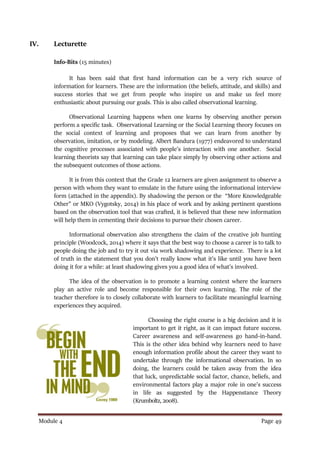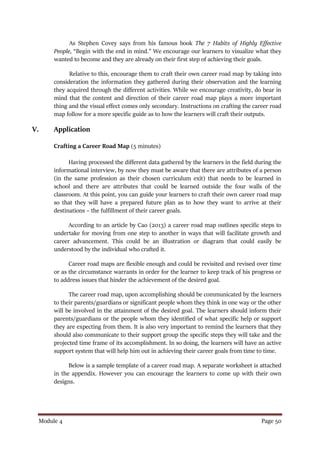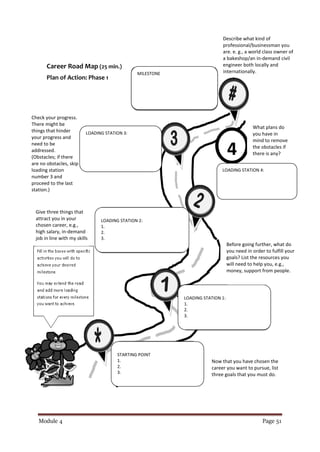This module helps students analyze career choices by having them interview people in fields they are interested in and create career roadmaps. It includes activities where students gather information about beliefs, attitudes and skills needed for different jobs through informational interviews. They then evaluate this data and identify common traits. Students also reflect on their progress and create diagrams or illustrations depicting their plans and goals for the future. The module aims to help students affirm their career decisions and develop plans to achieve their goals.












![Module 4 Page 57
Activity Sheet No. 1
INFORMATIONAL INTERVIEW
INTERVIEWEE’S PERSONAL PROFILE:
Name: (optional) _____________________________________________________________
Occupation/Business: _________________________________________________________
Highest Educational Attainment: ________________________________________________
Name of Company (if employed): _______________________________________________
No. of Years in the Job: _______________________________________________________
Type of Business (if there is any): _______________________________________________
No. of Years in Business: ______________________________________________________
QUESTIONS
PART I.
1. What are your typical job or business duties and responsibilities?
[Ano-ano po ang inyong mga tipikal na tungkulin at responsibilidad sa trabaho o
negosyong inyong pinapasukan?]
___________________________________________________________________________
___________________________________________________________________________
___________________________________________________________________________
______________________________________________________________
2. What are the necessary skills for this type of job or business?
[Ano-ano ang mga kasanayan o skills na kinakailangan sa trabaho o negosyo ninyo?]
___________________________________________________________________________
___________________________________________________________________________
___________________________________________________________________________
_______________________________________________________________
3. What is the most satisfying aspect of your job or business?
[Ano po ang nagbibigay-kasiyahan sa inyo sa trabaho o negosyong inyong pinapasukan?]
___________________________________________________________________________
___________________________________________________________________________
___________________________________________________________________________
_______________________________________________________________](https://image.slidesharecdn.com/cgpgrade12module-4-edited-211108020715/85/Cgp-grade-12-module-4-edited-13-320.jpg)
![Module 4 Page 58
4. What is the most challenging aspect of your job or business?
[Ano naman po ang mga hamon o balakid na nakikita ninyo sa inyong trabaho o negosyo?]
___________________________________________________________________________
___________________________________________________________________________
___________________________________________________________________________
_______________________________________________________________
5. What are the personal characteristics, values, and attitude that are needed in your job or
business?
[Ano-ano po ang mga katangian, kahalagahan, at saloobin na kinakailangan sa trabaho o
negosyo ninyo?]
__________________________________________________________________________
__________________________________________________________________________
__________________________________________________________________________
______________________________________________________________
6. Do you also possess these characteristics, values, and attitudes?
If yes, what are those that you possess?
[Mayroon din po ba kayong ng mga katangian, kahalagahan, at saloobing ito? Kung
mayroon, ano-ano po ang mga ito?
___________________________________________________________________________
___________________________________________________________________________
___________________________________________________________________________
_______________________________________________________________
PART II. Mission Statement, Guiding Principles, and Core Values
1. What are your guiding principles or beliefs that you are holding on to stay in your job or
business?
[Ano-ano pong mga prinsipyo at paniniwala ang inyong pinanghahawakan kung bakit
nananatili kayo sa inyong trabaho o negosyo?]
___________________________________________________________________________
___________________________________________________________________________
___________________________________________________________________________
___________________________________________________________________________](https://image.slidesharecdn.com/cgpgrade12module-4-edited-211108020715/85/Cgp-grade-12-module-4-edited-14-320.jpg)
![Module 4 Page 59
2. Does the company or business where you belong have a mission statement and core
values? If yes, what is the mission statement of your company? What are its core values?
[Ang kompanya o negosyong inyong pinapasukan ay may sinusunod bang pahayag na
misyon (mission statement) at mahahalagang pag-uugali (core values)?
Kung oo, ano ang pahayag na misyon ng inyong kumpanya o negosyo?
Ano-ano naman ang mahahalagang pag-uugali nito?
___________________________________________________________________________
___________________________________________________________________________
___________________________________________________________________________
___________________________________________________________________________
PART III. Advice and Suggestions
What is your advice for me as a Grade 12 learner who likes to enter in this same field of
work or business that you have or you are in ?
[Anong payo po ang maibibigay ninyo sa isang mag-aaral sa Grade 12 na katulad ko na
nagbabalak ding pasukin sa hinaharap ang trabaho o negosyong katulad ng sa inyo?]
___________________________________________________________________________
___________________________________________________________________________
___________________________________________________________________________
___________________________________________________________________________](https://image.slidesharecdn.com/cgpgrade12module-4-edited-211108020715/85/Cgp-grade-12-module-4-edited-15-320.jpg)




